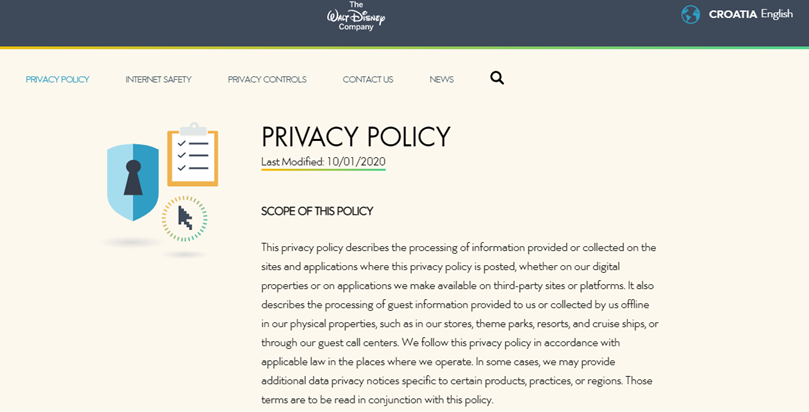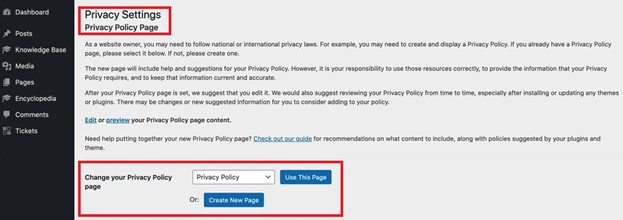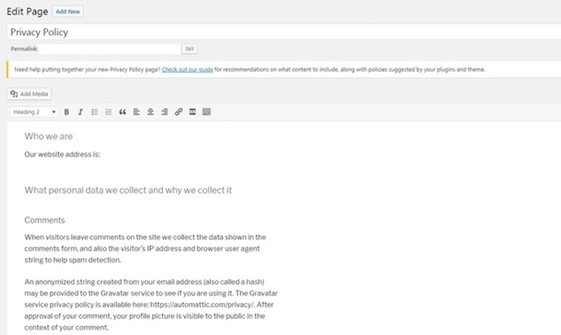If you are looking to launch an international WordPress website, which you definitely should, you will need to set up a privacy policy that is GDPR (General Data Protection Regulation) compliant. If you do not know what GDPR is, the EU’s regulation protects personal information and gives users more control over it. GDPR forces organizations to make sure that personal data is collected legally and under strict conditions.
Sites that collect and manage that information are obliged to protect it from misuse and/or exploitation. If, however, those responsible for the website fail to do so, they face penalties. GDPR applies to organizations that operate within the EU and any other organization outside of the EU that sells goods and/or services within the EU. Therefore, most major businesses need a privacy policy to appease GDPR.
So, if your website collects any personal information (most WordPress websites do) or you plan on using Google Analytics, which does the same thing, you are legally required to have a privacy policy in place.
It’s safe to assume that you’d like to avoid any problems with this, so set up a GDPR compliant privacy policy, and you will be good to go. To start off, we’ll get into a bit more detail about privacy policies and then go through the steps necessary to set one up, so bear with us a little longer.
What Is a Privacy Policy

A “Privacy Policy” is a written statement that discloses your visitors’ collected information on your WordPress website. Such information is mostly collected via cookies, but other types of information such as personal data filled out during the registration process are also protected. Even though users voluntarily provide information, it doesn’t mean that websites can do whatever they please with it. Site owners can collect such information using Google Analytics or other stats counters, so a disclosure statement is needed to make its usage is transparent.
Typically, website owners opt to serve advertisements and share their personal data with advertising partners, which might not please everyone. For example, if you are building your contacts list, you will need to assure users you won’t be sharing or selling their email addresses to third-party websites.
Why Your WordPress Website Needs a Privacy Policy

By signing up with WordPress’s terms of service (ToS), you are already complying with various privacy laws and practices. In their ToS, they state that you need to take care of personal information and protect it at all costs. Therefore, if you do not have a compliant privacy policy, you will be in breach of their regulations, resulting in the suspension of your WordPress account. A privacy policy page protects your business from legal issues and allows your users to trust you more, which is always a good thing.
Nowadays many users of both ends are making use of Residential Proxies as a way to provide security between the servers and outside traffic. Many users might want to protect their data and also keep their anonymity on the website because of the fear that the data is being misused. That’s why creating a detailed privacy policy is essential.
Basically, if your site collects any personal information, you require a privacy policy, and there is no way around it.
However, this practice does not just protect personal data. It also helps with SEO, allowing you to run advertisements on your website, making it GDPR compliant as well as adherent to the law.
What a Privacy Policy Contains
If you’re wondering what a proper privacy policy looks like, you have come to the right place.

Here are a few things you need to look out for:
- What type of data your site collects, such as names, emails, and possibly payment details from its users.
- What features or “web elements” on your site collect data like contact and opt-in forms, social media buttons, and comments.
- Why is the data collected, and what it’s used for?
- How you store data, and for how long?
- Who you share the data with?
- How you protect said data, and what procedures have you put in place to keep it safe in case of a breach.
- Mention that you use third-party tools for collecting stats.
- What rights do your visitors have over their personal (stored) data? You should include the right to know, ask for a copy or deletion of all aforementioned elements.
How to Incorporate a Privacy Policy into Your WordPress Website
If you’re running the latest version, WordPress 4.9.6+, which you probably are, you can use the built-in private policy template. It’s rather easy to set up. Their standard policy page is perfect for a blog or startup eCommerce website. If you are still running an older version, the easiest way to obtain a privacy policy is to update WordPress.
Setting up WordPress’ Built-in Privacy Policy Template
You can easily create a privacy policy in WordPress by simply navigating to Settings > Privacy in your dashboard. Now, select the page where you want to display your “Privacy Policy.”

In case you don’t have an existing page, simply click on “Create New Page” and create a new one. Existing pages come in handy as it is easier to update your policy at any time, which is something you’ll have to do eventually. If you decide to create a new page, it will take you to the WordPress editor, and you can start adding content to your page without much hassle.
WordPress’ template automatically takes care of the following sections:
- Who we are
- What personal data we collect, and why we collect it
- Who we share your data with
- How long we retain your data
- What rights you have over it
- Where we send it
- Contact information
- Additional information
By default, WordPress’ “What personal data we collect and why we collect it” specifies how your WordPress website gathers information via different methods and elements. However, you can edit these sections and provide more information if need be.

Upon publishing your “Privacy Policy”, it’s highly suggested you add a link to it in the footer area of your website. Even though it is quite easy to set up a privacy policy by using WordPress’s template, it is still a static tool that will most likely require maintenance and/or updating, as it does not automatically update, to appease future changes in the law. For that reason, it’s advised to monitor these changes and update your policies as soon as possible.
You see, the output can’t provide all the specific disclosures that each privacy law requires. For example, WordPress cannot customize your policy based on specific factors, including the information you collect, how you process it, and who you share it with.
Conclusion
Setting up a privacy policy for your WordPress website is not that hard, and you really should set one up! Even if you’re a small business, non-profit, freelancer, or blogger, you could be required to display a privacy policy on your site that complies with various laws. If you have followed all of the steps, you are sure to find setting one up quite easy by using WordPress’s built-in template. As was already mentioned, this will benefit you more than one way, so there’s no reason to skip it. Do yourself and your WordPress website a favor and take care of it as soon as possible.

